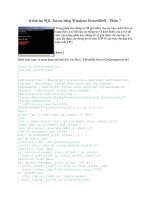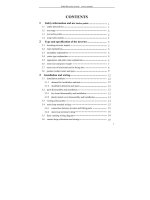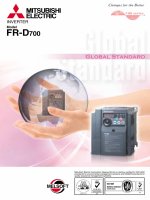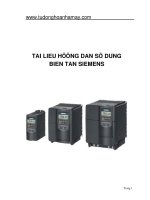tài liệu biến tần SK Getting Started Guide Commander phần 7 docx
Bạn đang xem bản rút gọn của tài liệu. Xem và tải ngay bản đầy đủ của tài liệu tại đây (157.74 KB, 10 trang )
Commander SK Size 2 to 6 Getting Started Guide 61
Issue Number: 7 www.controltechniques.com
Safety Information
Product
Information
Mechanical
Installation
Electrical
Installation
Keypad and
Display
Parameters
Quick start
commissioning
Diagnostics Options
UL listing
information
0: Coast to stop selected
1: Ramp to stop selected
2: Ramp to stop with 1 second DC injection braking
3: DC injection braking with detection of zero speed
4: Timed DC injection braking
See the Commander SK Advanced User Guide.
OFF: Fixed linear voltage to frequency ratio (constant torque - standard load)
On: Voltage to frequency ratio dependant on load current (dynamic/variable torque/
load). This gives a higher motor efficiency.
0: Disabled
1: Detect positive and negative frequencies
2: Detect positive frequencies only
3: Detect negative frequencies only
If the drive is to be configured in fixed boost mode (Pr 41 = Fd or SrE) with catch a
spinning motor software enabled, an autotune (see Pr 38 on page 63) must be carried
out to measure the motor’s stator resistance beforehand. If a stator resistance is not
measured, the drive may trip on OV or OI.AC while trying to catch a spinning motor.
dig: Digital input
th: Motor thermistor input, connect as per diagram below
Fr: Frequency input. See Commander SK Advanced User Guide.
Fr.hr: High resolution frequency input. See Commander SK Advanced User Guide.
Figure 6-11
Trip resistance: 3kΩ
Reset resistance: 1k8
No Function Range Defaults Type
31 Stop mode select 0 to 4 1 RW
No Function Range Defaults Type
32 Dynamic V to f select OFF or On OFF RW
No Function Range Defaults Type
33 Catch a spinning motor select 0 to 3 0 RW
No Function Range Defaults Type
34 Terminal B7 mode select dig, th, Fr, Fr.hr dig RW
0V
Motor thermistor
input
T1
B7
If Pr 34 is set to th so that terminal B7 is used as a motor thermistor, the functionality of
terminal B7 as set-up with Pr 05, drive configuration, will be disabled. Analog reference
2 will no longer be selected as the speed reference. Analog reference 1 should be used.
NOTE
When Pr 34 is set to th, the mode button will need to be pressed four times to return the
drive display to status mode.
NOTE
62 Commander SK Size 2 to 6 Getting Started Guide
www.controltechniques.com Issue Number: 7
n=0: At zero speed
At.SP: At speed
Lo.SP: At minimum speed
hEAL:Drive ok
Act: Drive active
ALAr: General drive alarm
I.Lt: Current limit active
At.Ld: At 100% load
USEr: User programmable
Fr: Voltage proportional to motor speed
Ld: Voltage proportional to motor load
A: Voltage proportional to output current
Por: Voltage proportional to output power
USEr: User programmable
3:3kHz
6:6kHz
12: 12kHz
See the Commander SK Technical Data Guide for drive derating data.
No Function Range Defaults Type
35 Digital output control (terminal B3)
n=0, At.SP, Lo.SP, hEAL,
Act, ALAr, I.Lt, At.Ld, USEr
n=0 RW
This parameter is automatically changed by the setting of Pr 12. When Pr 12
automatically controls the setting of this parameter, this parameter cannot be changed.
NOTE
A change to Pr 35 is set by pressing the MODE key on exit from parameter edit
mode. See the Commander SK Advanced User Guide.
NOTE
M
Terminal B3 can also be configured as a digital input, frequency output or PWM output.
Refer to the Commander SK Advanced User Guide. for more information.
No Function Range Defaults Type
36 Analog output control (terminal B1) Fr, Ld, A, Por, USEr Fr RW
NOTE
A change to Pr 36 is set by pressing the MODE key on exit from parameter edit
mode. See the Commander SK Advanced User Guide
NOTE
M
No Function Range Defaults Type
37 Maximum switching frequency 3, 6, 12 3 RW
Drive size Voltage rating 3kHz 6kHz 12kHz
2All√√ √
3
SK320X √√ √
SK3401 & SK3402 √√ √
SK3403 √√ √
SK350X √√
4All√√
5All√√
6All√√
Commander SK Size 2 to 6 Getting Started Guide 63
Issue Number: 7 www.controltechniques.com
Safety Information
Product
Information
Mechanical
Installation
Electrical
Installation
Keypad and
Display
Parameters
Quick start
commissioning
Diagnostics Options
UL listing
information
0: No autotune
1: Non-rotating static autotune
2: Rotating autotune
Enter the motor rated frequency (taken from the motor name plate). This defines the
voltage to frequency ratio applied to the motor.
Auto: Automatically calculates the number of motor poles from the settings of Pr 07
and Pr 39
2P: Set for a 2 pole motor
4P: Set for a 4 pole motor
6P: Set for a 6 pole motor
8P: Set for an 8 pole motor
Ur S: Stator resistance is measured each time the drive is enabled and run
Ur: No measurement is taken
Fd: Fixed boost
Ur A: Stator resistance is measured the first time the drive is enabled and run
Ur I: Stator resistance measured at each power-up when the drive is enabled and
run
SrE: Square law characteristic
In all Ur modes, the drive operates in open loop vector mode.
No Function Range Defaults Type
38 Autotune 0 to 2 0 RW
When a rotating autotune is selected, the drive will accelerate the motor up to
2
/
3
maximum speed in Pr 02. Once a rotating autotune has been initiated (Pr 38 set to 2)
on Commander SK, it must be completed before the drive will operate normally. If the
rotating auto-tune is not completed (through the drive being disabled or a trip
occuring), the drive will only run at the autotune speed (2/3 rated speed reference)
when the drive is asked to run again.
WARNING
The motor must be at a standstill before a non-rotating autotune is initiated.
The motor must be at a standstill and unloaded before a rotating autotune is initiated.
NOTE
NOTE
No Function Range Defaults Type
39 Motor rated frequency 0.0 to 1500.0 Hz Eur: 50.0, USA: 60.0 RW
No Function Range Defaults Type
40 Number of motor poles Auto, 2P, 4P, 6P, 8P Auto RW
No Function Range Defaults Type
41 Voltage mode select Ur S, Ur, Fd, Ur A, Ur l, SrE Eur: Ur I, USA: Fd RW
The drive default setting is Ur I mode which means that the drive will carry out an
autotune every time the drive is powered-up and enabled. If the load is not going to be
stationary when the drive is powered-up and enabled, then one of the other modes
should be selected. Not selecting another mode could result in poor motor performance
or OI.AC, It.AC or OV trips.
NOTE
64 Commander SK Size 2 to 6 Getting Started Guide
www.controltechniques.com Issue Number: 7
Determines the boost level when Pr 41 is set to Fd or SrE.
2.4: 2400 baud
4.8: 4800 baud
9.6: 9600 baud
19.2: 19200 baud
38.4: 38400 baud
Defines the unique address for the drive for the serial interface.
Indicates the version of software installed to the drive.
Pr 46 to Pr 51 appear when Pr 12 is set to control a motor brake
Defines the brake release and brake apply current thresholds as a % of motor current.
If the frequency is >Pr 48 and the current is >Pr 46, the brake release sequence is
started.
If the current is <Pr 47, the brake is applied immediately.
Defines the brake release and brake apply frequencies.
If the current is >Pr 46 and the frequency is > Pr 48, the brake release sequence is
started.
If the frequency is <Pr 49 and the drive has been commanded to stop, the brake is
applied immediately.
Defines the time between the frequency and load condition being met and the brake
being released. The ramp is held during this time.
Defines the time between the brake being released and the ramp hold being released.
No Function Range Defaults Type
42 Low frequency voltage boost 0.0 to 50.0 % Eur: 3.0, USA: 1.0 RW
No Function Range Defaults Type
43 Serial communications baud rate 2.4, 4.8, 9.6, 19.2, 38.4 19.2 RW
No Function Range Defaults Type
44 Serial comms address 0 to 247 1 RW
No Function Range Defaults Type
45 Software version 1.00 to 99.99 RO
No Function Range Defaults Type
46 Brake release current threshold
0 to 200 %
50
RW
47 Brake apply current threshold 10
No Function Range Defaults Type
48 Brake release frequency
0.0 to 20.0 Hz
1.0
RW
49 Brake apply frequency 2.0
No Function Range Defaults Type
50 Pre-brake release delay 0.0 to 25.0 s 1.0 RW
No Function Range Defaults Type
51 Post brake release delay 0.0 to 25.0 s 1.0 RW
Commander SK Size 2 to 6 Getting Started Guide 65
Issue Number: 7 www.controltechniques.com
Safety Information
Product
Information
Mechanical
Installation
Electrical
Installation
Keypad and
Display
Parameters
Quick start
commissioning
Diagnostics Options
UL listing
information
Figure 6-12 Brake function diagram
Figure 6-13 Brake sequence
Pr 52 to Pr 54 appear when a Solutions Module is installed to the drive
Current
magnitude
Brake release
current threshold
Brake apply
current threshold
46
47
+
_
Motor
frequency
Brake release
frequency
Brake apply
frequency
48
49
+
_
+
_
Reference
enabled
Latch
Drive
active
In
Out
Reset
Pre-brake
release
delay
50
Post brake
release
delay
51
Brake
release
Brake
controller
enable
12
T5
T6
B3
User
programmable
Brake
disabled
Ramp
hold
88
85
91
No Function Range Defaults Type
52 *Solutions Module dependant 0RW
Pr Brake
release frequency
48:
Pr : Brake release
current threshold
46
Ramp hold
Pr :
Brake apply
frequency
49
Pr :
Pre brake
release delay
50
Pr :
Post brake
release delay
51
Brake release
Output current
Output frequency
Pr :
47
Brake apply
current threshold
No Function Range Defaults Type
53 *Solutions Module dependant 0RW
66 Commander SK Size 2 to 6 Getting Started Guide
www.controltechniques.com Issue Number: 7
*See the Commander SK Advanced User Guide for further information.
Indicates the last 4 trips of the drive.
The PLC ladder program enable is used to start and stop the PLC ladder program.
0: Stop the PLC ladder program
1: Run the PLC ladder program (trip drive if LogicStick is not installed). Any out-of-
range parameter writes attempted will be limited to the maximum/minimum
values valid for that parameter before being written to.
2: Run the PLC ladder program (trip drive if LogicStick is not installed). Any out-of-
range parameter writes attempted will cause the drive to trip.
See the Commander SK Advanced User Guide for details on PLC ladder programming.
The PLC ladder program status parameter indicates the actual state of the PLC ladder program.
-n: PLC ladder program caused a drive trip due to an error condition while running
rung n. Note that the rung number is shown on the display as a negative
number.
0: LogicStick is installed with no PLC ladder program
1: LogicStick is installed, PLC ladder program is installed but stopped
2: LogicStick is installed, PLC ladder program is installed and running
3: LogicStick is not installed
Pr 61 to Pr 70 and Pr 71 to Pr 80 can be used to access and adjust advanced
parameters.
Example: It is desired that Pr 1.29 (Skip frequency 1) is to be adjusted. Set one of the
parameters Pr 71 to Pr 80 to 1.29, the value of Pr 1.29 will appear in the corresponding
parameter from Pr 61 to Pr 70. I.e. if Pr 71 is set to 1.29, Pr 61 will contain the value of
Pr 1.29 where it can be adjusted.
No Function Range Defaults Type
54 *Solutions Module dependant 0RW
No Function Range Defaults Type
55 Last trip
0RO
56 Trip before Pr 55
57 Trip before Pr 56
58 Trip before Pr 57
No Function Range Defaults Type
59 PLC ladder program enable 0 to 2 0 RW
No Function Range Defaults Type
60 PLC ladder program status -128 to +127 RO
No Function Range Defaults Type
61 to
Configurable parameter 1 to
configurable parameter 10
As source
70
Some parameters are only implemented if the drive is disabled, stopped or tripped and
the STOP/RESET key is pressed for 1s.
See Commander SK Advanced User Guide for advanced parameter details.
NOTE
Commander SK Size 2 to 6 Getting Started Guide 67
Issue Number: 7 www.controltechniques.com
Safety Information
Product
Information
Mechanical
Installation
Electrical
Installation
Keypad and
Display
Parameters
Quick start
commissioning
Diagnostics Options
UL listing
information
6.3 Parameter descriptions - Level 3
Set Pr 71 to Pr 80 to the required advanced parameter number to be accessed.
The value within these parameters will be displayed in Pr 61 to Pr 70. Pr 61 to Pr 70 can
then be adjusted to change the value within a parameter.
See Commander SK Advanced User Guide for further details.
6.4 Diagnostic parameters
The following read only (RO) parameters can be used as an aid to fault diagnosis on the
drive. See Figure 8-1 Diagnostics logic diagram on page 74.
No Function Range Defaults Type
71 to
Pr 61 to Pr 70 set up 0 to Pr 21.51
RW
80
No Function Range Type
81 Frequency reference selected ±Pr 02 Hz RO
82 Pre-ramp reference ±Pr 02 Hz RO
83 Post-ramp reference ±Pr 02 Hz RO
84 DC bus voltage 0 to Drive maximum Vdc RO
85 Motor frequency ±Pr 02 Hz RO
86 Motor voltage 0 to Drive rating V RO
87 Motor speed ±9999 rpm RO
88 Motor current +Drive maximum A RO
89 Motor active current ±Drive maximum A RO
90 Digital I/O read word 0 to 95 RO
91 Reference enabled indicator OFF or On RO
92 Reverse selected indicator OFF or On RO
93 Jog selected indicator OFF or On RO
94 Analog input 1 level 0 to 100 % RO
95 Analog input 2 level 0 to 100 % RO
68 Commander SK Size 2 to 6 Getting Started Guide
www.controltechniques.com Issue Number: 7
7 Quick start commissioning
This procedure is written from default parameter settings as the drive would be
delivered from the factory.
For European default settings refer to section 7.1 Terminal control . For USA default
settings refer to section 7.2 Keypad control on page 70.
7.1 Terminal control
Figure 7-1 Minimum required control terminal connections
Terminal B7 open: Local voltage speed reference (A2) selected
0V
Remote current speed
reference input (A1)
+10V reference output
Local voltage speed
reference input (A2)
+24V output
Drive Enable/Reset
Run Forward
Run Reverse
Local (A2)/Remote (A1)
speed reference select
10k
(2kmin)
Eur USA
Analog output
(motor speed)
Digital output
(zero speed)
Speed
potentiometer
0V
Remote current speed
reference input (A1)
+10V reference output
Local voltage speed
reference input (A2)
+24V output
/Stop
Run
Jog
Local (A2)/Remote (A1)
speed reference select
10k
(2kmin)
Analog output
(motor speed)
Digital output
(zero speed)
Speed
potentiometer
T1
T2
T3
T4
B1
B2
B3
B4
B5
B6
B7
T1
T2
T3
T4
B1
B2
B3
B4
B5
B6
B7
Commander SK Size 2 to 6 Getting Started Guide 69
Issue Number: 7 www.controltechniques.com
Safety Information
Product
Information
Mechanical
Installation
Electrical
Installation
Keypad and
Display
Parameters
Quick start
commissioning
Diagnostics Options
UL listing
information
Action Detail
Before power up
Ensure:
• The drive enable signal is not given, terminal B4 is open
• The run signal is not given, terminal B5/B6 is open
• The motor is connected to the drive
• The motor connection is correct for the drive Δ or Y
• The correct supply voltage is connected to the drive
Power up the drive
Ensure:
• The drive displays:
Enter minimum
and maximum
speeds
Enter:
• Minimum speed Pr 01 (Hz)
• Maximum speed Pr 02 (Hz)
Enter acceleration
and deceleration
rates
Enter:
• Acceleration rate Pr 03 (s/100Hz)
• Deceleration rate Pr 04 (s/100Hz)
Enter motor
nameplate details
Enter:
• Motor rated current in Pr 06 (A)
• Motor rated speed in Pr 07 (rpm)
• Motor rated voltage in Pr 08 (V)
• Motor rated power factor in Pr 09
• If the motor is not a standard 50/60Hz motor, set Pr 39
accordingly
Ready to autotune
Enable and run the
drive
Close:
• The Enable and Run Forward or Run Reverse signals
Autotune
The Commander SK will carry out a non-rotating autotune on the
motor.
The motor must be stationary to carry out an autotune correctly.
The drive will carry out a non-rotating autotune every time it is first
started after each power-up. If this will cause a problem for the
application, set Pr 41 to the required value.
Autotune complete
When the autotune has been completed, the display will show:
Ready to run
Run The drive is now ready to run the motor.
Increasing and
decreasing speed
Turning the speed potentiometer will increase and decrease
the speed of the motor.
Stopping
To stop the motor under ramp control, open either the run
forward or run reverse terminal.
If the enable terminal is opened while the motor is running,
the motor will coast to a stop.
Pr 02
t
Pr 01
100Hz
Pr 03
t
Pr 04
Mot X XXXXXXXXX
No XXXXXXXXXX kg
IP55 I.cl F C 40 s S1
°
VHzmin
-1
kW cos
φ
A
230
400
50 1445 2.20 0.80 8.50
4.90
CN = 14.5Nm
240
415
50 1445 2.20 0.76 8.50
4.90
CN = 14.4Nm
CTP- VEN 1PHASE 1=0,46A P=110W R.F 32MN
I.E.C 34 1(87)
cos
∅
σ
L
S
R
S
70 Commander SK Size 2 to 6 Getting Started Guide
www.controltechniques.com Issue Number: 7
7.2 Keypad control
Figure 7-2 Minimum required control terminal connections
0V
+10V reference output
+24V output
Drive Enable/Reset
Forward/Reverse
Analog output
(motor speed)
Digital output
(zero speed)
Not used
Not used
Not used
Not used
T1
T2
T3
T4
B1
B2
B3
B4
B5
B6
B7
To implement a Forward/Reverse switch from the drive’s display:
•Set Pr 71 to 8.23
•Set Pr 61 to 6.33
• Press the STOP/RESET key
Terminal B5 will now be set-up as a Forward/Reverse terminal.
NOTE









